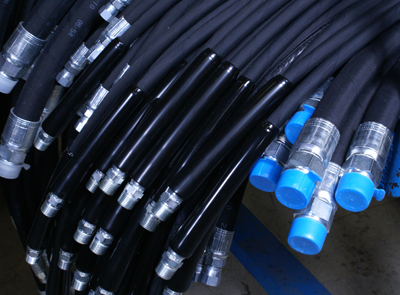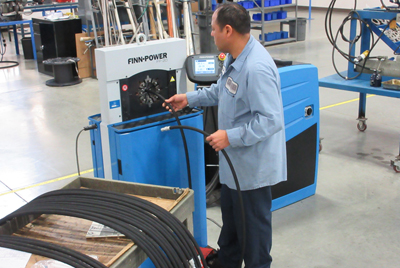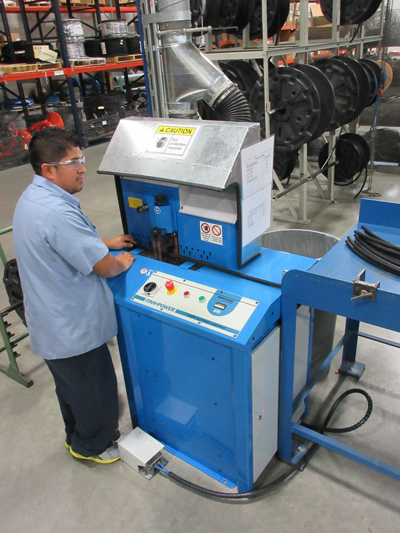
The GEIB product line consists of hydraulic, metal, industrial, Teflon (PTFE), thermoplastic, and composite hoses. Using Lillbacka Finn-Power crimpers and hose cutting machines allows the company to offer this type of diversity.
Working with the right suppliers is key to the growth of Geib Industries, which focuses solely on fabricating hose assemblies and hose-related products. With 70 years in business, the company was able to expand into a 74,000 ft2 facility in Bensenville, Ill., last year. The company said this longevity is due to its dedication to helping its customers fill their hose and fittings requirements.
What sets the company apart from its competitors is its focus on only hose assemblies and hose related products. “Our product line consists of hydraulic, metal, industrial, Teflon (PTFE), thermoplastic, and composite hoses,” said Chris Geib, president. “There aren’t many companies that have the ability to fabricate all hose varieties in-house. Hose is all we do…and we really focus on it.”
The business also has a very diverse customer base that has helped the company maintain a steady growth trajectory. “Each year, the company grows from anywhere between 3 to 12%,” said Geib. “We don’t have large peaks and valleys because we have such a diverse customer base that crosses over many different industries. And we are equally divided between OEM and MRO accounts, which also helps with our diversification. We don’t hone in on one particular market segment then live and die in it.”
The company plays in a variety of markets, including industrial engine builders, pump manufacturers, food processing, hydraulic equipment, packaging, steel mills, petrochemical plants, and nuclear power plants. “We really excel when a customer needs a hose-centric supplier,” Geib said. “If hose is an important piece of their business, that’s when we shine. We have the ability to provide all hose products, the service, the engineering, and the know-how customers need from one source.”
Suppliers are key to success

A Geib technician uses the Finn-Power FP20UC crimper.
Geib said the company chooses its suppliers carefully and that it aligns itself with highly respected suppliers. This is why the company only uses Lillbacka Finn-Power crimpers and hose cutting machines. The company switched to Finn-Power from another brand, said Mike Mirch, general manager. “They were real dinosaurs in terms of stroke speed. They were very slow and had very low tonnage,” Mirch said. “In addition, the older crimpers had huge footprints.”
Geib replaced the old crimpers with five Finn-Power crimpers and one hose-cutting machine because the company touts itself as a job shop, not a production house. “We crimp small lots of 5, 10, 15, 20 units,” Mirch said. “Each Finn-Power crimper is performing a different service for the different styles of hoses that we sell.”
The latest additions have been the Finn-Power FP20UC crimper and the CM75PH hose-cutting machine.
The FP20UC serial production crimper was designed for high-volume production applications that require optimal crimping force, speed, and efficiency. It offers a 10 to 61 mm crimping range and operates with a 1500 kN crimping force. The FP20UC is highly efficient and can produce 2,300 crimps per hour quickly, accurately, with high repeatability, and quality.
In addition, it features a UC Controller, which offers automated quality control reporting options and an easy-to-use menu guided operation. The UC Controller has many options such as pressure crimping, multi-step crimping, and process control monitoring. It also has energy-efficient modes to place the crimper into a standby mode when not in operation.

Here, a Geib works with the Finn-Power CM75PH hose cutting machine. Both machines have helped increase Geib’s productivity and quality.
When Geib purchased the FP20UC crimper, it also purchased the Finn-Power CM75PH hose-cutting machine. This hose-cutting machine is designed to cut all types of hose up to 2 and 3 in. diameter, 6-spiral hoses. The 520/650 mm diameter blades operate at 3,000 rpm. The hose is pushed against the blade by a pneumatic cylinder. Piston movement speed can be quickly and easily adjusted to choose optimal cutting speed for each type of hose. Lower speeds are used with thick hoses to avoid overheating of the blade. The blade can be re-sharpened when necessary. The cutter has a built-in bin for the collection of cutting waste.
Another Finn-Power crimper feature that Geib staff likes is the Quick Change Tool System (QC), which allows the entire die set to be changed in one easy operation. The pins on the QC Tool engage the QC holes in the dies. As the master dies open/close, the die segments are released from the master dies and retained by the QC tool. The die segments are held to the tool by a magnet. The die set then can be stored in the QC storage rack. In this way, the segments are kept in complete sets and are always used in the same order. “The speed of the Finn-Power crimper is definitely a benefit, both in the stroke of the crimping and in the ability to quickly change dies,” explains Geib. “Because we are a job shop, we change on every order. The order has 6 or 7 line items, and 80% of the time each one of these different line items will need to have a different die change.”
Finally, integrity of the crimp is very important for Geib. “We have a tremendous maintenance schedule, and the Finn-Power crimpers are extremely sturdy and reliable. They keep their ovality, and the crimp spec is always right on. We also use the Finn-Power crimpers for coolant lines and large oxygen and water hoses used in the primary metals market, and steam hose assemblies used in oil and gas refineries, nuclear power plants, etc.
“New customers often visit our facility,” said Geib. “They are impressed by the ease of use of the Finn-Power crimpers and their attractive appearance. The crimpers really help us sell our facility. There is a lot of engineering in the crimpers. They are very reliable, the hardest working, and the most durable.”
Lillbacka
www.lillbackausa.com
Filed Under: Hose Assembly Tips
